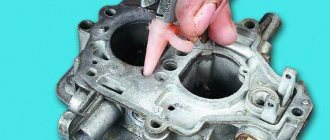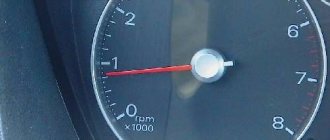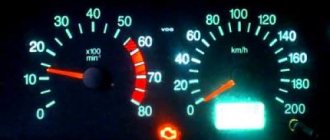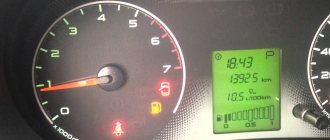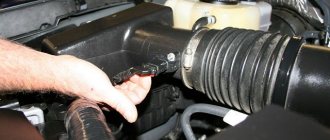Intake system leakage
Air must enter the engine only through the intake manifold. If the intake is damaged, air is sucked in from outside. Because of this, when starting the engine, the speed fluctuates, the engine does not hold speed at idle at all (stalls), and in some cases it is simply impossible to start. Air leaks in different places:
- through the walls of the collector (a common “disease” of plastic collectors in which microcracks form);
- through vacuum hoses;
- in the connection of pipes and hoses.
Intake manifold
If the collector is not damaged, but the “idles” begin to float, it is worth inspecting the gasket. Over time, it dries out and allows air to pass through. More “unaccounted” oxygen enters the cylinder - the mixture becomes lean, the internal combustion engine stalls. The situation is the same with the throttle valve gasket - the engine suffocates and does not hold speed at idle.
We carefully inspect the air pipes. Due to frequent and large temperature changes, rubber tubes dry out and crack. Why do engine speeds start to fluctuate? Air “unaccounted for” by the sensors again enters the combustion chamber, which leads to a situation similar to the previous one.
Air pipe
The engine may stall due to damaged vacuum hoses. Since they serve to transmit vacuum, the ingress of excess oxygen will instantly affect the operation of the car.
If your car has a gasoline vapor adsorber, inspect the valve. This is a common disease in domestic cars.
Canister valve
It is a faulty adsorber valve that causes the engine to go crazy. Replacing the valve helps eliminate the vibration problem at idle.
Common places for air leaks
- Loose clamps on pipes and vacuum hoses.
- Cracks in rubber hoses and pipes. Most often found near clamps, in places of contact with elements of attachments.
- Broken brake booster diaphragm.
- Leaking vacuum valves (PCV, EGR, absorber purge valve). The cause of the leak is a leaky membrane, but cracks in the housing should not be ruled out. If your car is equipped with HBO, check the vacuum corrector.
On Japanese-made cars, when troubleshooting, pay attention to the system of vacuum valves involved in adjusting the warm-up speed and opening the additional air channels.
- A crack in the plastic intake manifold due to a manufacturing defect or mechanical damage. Often such collectors consist of several elements assembled on sealing gaskets. If the gaskets become tanned due to temperature loads in the compressed state, air will be sucked into the intake manifold through them.
- Loose fit of the intake manifold to the cylinder head.
- Worn or incorrectly installed fuel injector O-rings.
- Wear of the throttle valve rotation axis in the housing (very common on Mitsubishi Lancer 9).
Idle speed control
The mechanism serves to maintain engine speed when the throttle valve is closed. The malfunction manifests itself in different ways: the car stalls, troits periodically, or constantly cannot go to idle.
Idle speed control
If you notice floating engine speeds, there are several reasons for the malfunction:
- Poor contact. The valve just doesn't seem to have any power. You need to inspect the wire terminals - often the terminals become oxidized and become covered with dirt.
- Dirt under the stem. If the regulator is disassembled, there is a chance to clean it - after reassembly, the problem goes away.
- Lack of lubrication in the rod. After lubrication, the valve operates normally.
When choosing a new regulator, it is advisable to avoid unknown manufacturers. Often such parts fail within a week, especially on Russian cars. If possible, try to purchase original parts.
Replacement
To replace the XX regulator, you do not have to be a professional. By doing the work yourself, you will gain a rewarding experience and can also save a fair amount of money.
The entire procedure must be carried out in strict sequence, which will allow everything to be done correctly and efficiently. Maybe even better than at a service station.
- Unplug your car. To do this, simply remove the negative terminal from your car's battery. We don't need short circuits or electric shocks.
- Disconnect the connector from the sensor. In the case of an injection engine installed on your VAZ 2110, to disconnect the pad you just need to press the plastic latch.
- Remove the two screws. Moreover, it is better to unscrew the left fastener first, and then the right screw.
Removing the device
- This will allow you to achieve what you want - remove the idle air control. Further operations are simple, like all previous activities.
- Before installing the new sensor in its rightful place, use regular engine oil to treat the O-ring.
- Inspect the condition of this same O-ring. During prolonged use, the seal may become deformed and become cracked. In this case, it is better to replace it with a new one.
- Next comes the calibration stage. You won’t have to make any serious efforts, since the electronic relay will take care of all the main calibration tasks.
- Turn the ignition on for a few minutes and then turn it off.
- If after the operations and calibration the revolutions stop floating, they are not increased and stable, you did everything right, and it was the XX sensor that was to blame.
As you can see, IAC is a fairly important element in the car system, which must be carefully monitored. A pleasant fact is that if troubles arise with the regulator, you can always replace it with your own hands in a matter of minutes.
The ability to implement feedback is an advantage of electronic fuel injection systems and their fundamental difference from other power systems of internal combustion engines. In this case, we are talking about controlling the mixture composition and directly regulating the engine operating mode itself - the injection ECU can either adjust the speed in a certain range (cars with a “mechanical” throttle) or control them (an “electronic” throttle).
However, situations are possible when the ECM is not able to support the desired mode. One of the characteristic symptoms of this is the “swimming” of revolutions, their constant change with clearly defined periodicity.
Idle jet
If you have a carburetor with variable speed, inspect the jets. If dirt gets into them, the mixture becomes lean and the engine runs unstably.
Carburetor jet
Unscrew the solenoid valve and remove the XX jet. Using carburetor cleaner, wash off dirt, dry and reinstall. By the way, sometimes the reason lies not in the jet itself, but in the o-ring. After replacing it, the engine works properly.
Carburetor engine
On carbureted cars, the carburetor is almost always at fault.
Among the huge number of reasons causing idle instability, the main ones are:
- Unregulated idle mode, lean mixture.
- Solenoid valve defective. This is evidenced by the engine running only on suction.
- The jets and idle passages are clogged. The mixture lacks air.
- It is sucked in and the mixture becomes leaner, as a result of which the engine stalls if the choke is not pulled out.
In this case, the temperature of the fuel at the end of the compression moment should not exceed this value of fuel ignition.
Crankcase ventilation valve
The mechanism removes gases from the crankcase into the combustion chamber through the intake manifold. Why does the speed fluctuate due to dirty ventilation? If the valve is clogged or does not open well, the pressure inside the system increases. Crankcase gases enter the combustion chamber in excess quantities. The malfunction can be noticed by traces of oil that is squeezed out of all seals and gaskets. If the engine speed begins to fluctuate, by cleaning or replacing this valve, the problem disappears.
Crankcase ventilation valve
It is important to know! The operation of the internal combustion engine is affected not only by the valve itself, but also by the condition of the ventilation system pipes.
They should be elastic and free of cracks. If the tube bends like plasticine and does not return to its original shape, we urgently replace it. This means that there is a critical layer of soot inside it.
Dirty crankcase ventilation pipe
The ventilation system is the “lungs” of the engine. By eliminating blockages, engine operation is stabilized in all aspects - speed is leveled, consumption is reduced, and the car picks up speed more easily.
Air flow sensor
It is located between the throttle valve and the air filter. The sensor determines the volume of air passed through and sends information to the ECU. The latter adjusts fuel injection based on its data.
Mass air flow sensor
Inside the mass flow sensor there is a temperature compensation resistor, which often fails. Because of this, the sensor incorrectly determines the volume of oxygen, and accordingly, the control unit makes incorrect corrections. In some cases, you can get by with cleaning the sensor, but often it has to be replaced entirely.
Owners often fell for low-quality sensors. An original mass air flow sensor can cost 10 thousand rubles or more.
Therefore, there is a temptation to buy a cheaper analogue. But after installing it, the problem does not go away (or it goes away, but not for long). And only with a new original sensor the unit receives the correct information.
Popular brands:
Mercedes-Benz GL-Class
Injector
Here everything is much more complicated: the operation of an injection engine is associated with many sensors, ECUs and other elements of the power unit, in particular the fuel system. But first things first.
Idle air control sensor (IAC)
If this device is faulty, the engine may stall at idle, or its speed will float, making jumps in the range of approximately 600-1200 rpm. Therefore, it is necessary to ensure that the device is working properly. This can be done using a multimeter. Procedure:
- First, measure the supply voltage on a pair of outer terminals A and D. To do this, place the black probe of the device to ground (any unpainted metal part of the car body), and the red one to the indicated terminals in turn. When the ignition is on, there should be 12 V. If this is not the case, check the voltage at the ECU terminals (for the VAZ 2110 these are pins 4 and 54). If there is 12 V here, look for an open circuit in the wiring.
- Set the tester to ohmmeter mode. Resistance between terminals A and B, C and D: should be 40-80 Ohms.
- Check the motor for short circuit. To do this, measure the resistance between A and D, B and C: the arrow of the device should tend to infinity.
TPDZ
That is, a throttle position sensor, which is responsible for the amount of fuel mixing with air. If the fuel supply is incorrect, the ECU will automatically give a command and the idle speed will increase. Therefore, it is necessary to check the TPS:
- Unclip the connector that fits the sensor: you will see 3 contacts: for the control signal, power and ground.
- Start the engine and measure the voltage at the power terminal: it should be approximately 5 V.
- Stop the engine and switch the tester to resistance measurement mode (throttle valve closed). Measure it between ground and signal contact: it should be 0.8-1.2 kOhm. When the damper is closed, the value is 2.3-2.7 kOhm.
How to remove and install a new sensor
To dismantle, simply unscrew a couple of mounting screws. Next, disconnect the end of the damper shaft and, rotating the new sensor, align the holes to screw in the screws. Put the connector on.
After completing the work, it is necessary to delete the error from the controller’s memory. To do this, remove the terminals from the battery for a period longer than 8 hours. If the error has not cleared, try driving in a gentle mode so that the ECU resets it itself. If you fail again, you will have to contact a car service (you will need a motor tester).
Throttle valve
Jamming of this mechanical device will result in an increase in the amount of air supplied to the cylinders. As a result, the ECU will work again and begin to increase the volume of fuel to balance the mixture. To solve the problem, remove the damper and clean it with chemicals. If there is no result, the part will have to be replaced.
Engine temperature sensor
As practice shows, this device breaks down quite often, because it is constantly exposed to temperature changes. It needs to be checked:
- Disconnect the block and with the ignition on (no need to start the engine), check the voltage at terminal “B” relative to ground: it should be 5 V. If the value is less than 4.7 V, you need to look for the reason: a break or short to ground is possible.
- Turn off the ignition and determine the resistance between contact “A” and ground: the correct value is 1 Ohm (no more and no less).
- Measure the resistance between ground and terminal “B”: it should be at least 1 Ohm.
- Check the functionality of the sensor. To do this, you need to measure the above resistances on a cold and warm engine. The values must be the same.
After the checks, it is recommended to reset the ECU errors, as indicated above in the section on TPS.
Mass air flow sensor (MAF)
During operation, this device gradually becomes covered with an oil film, which can lead to failure of the hot-wire anemometer, the element responsible for determining the amount of air. If the device does not cope with its task, the ECU receives incorrect information and the engine begins to increase speed.
Increased speed may also be due to a dirty air filter.
Intake manifold
It may have deformation or gasket breakdown. An increase in idle speed indicates an air leak.
To fix the problem you will have to remove the manifold. After dismantling, inspect it carefully: deformation can also affect engine warming up, its starting and other factors. Damage is eliminated by grinding, which is preferable to do in a car service center.
Electronic engine control unit
Incorrect operation of the ECU also affects high idle speeds. To restore the normal functioning of the “brains” you will need a special cable, computer and software.
It is highly not recommended to poke around here on your own: it is better to trust the specialists. In practice, after unprofessional intervention, the “do-it-yourselfers” still have to go to a specialized technical center to eliminate the consequences of their own “improvements.”
Generator
Although rare, it can also cause increased engine speed at idle. Why is this happening? If this unit does not produce enough current, the ECU will command the engine to spin up more strongly to bring the voltage up to normal. As a result, the turnover will increase.
Crankcase ventilation (PCV) system
It is needed to remove crankcase gases through a special valve in order to prevent pressure from increasing above normal.
If you can find the PCV valve, then carefully pinch the tube that fits it with pliers: when the engine is running, the speed should drop slightly. If this does not happen, the device must be replaced.
Turbocharger
Not all cars are equipped with such a “thing,” but it may be the “culprit” for high engine idle speeds, which can “automatically” decrease and increase. Air leaks may occur here due to a leak in the rotor shaft gasket. The same effect can be caused by wear of turbocharger parts (for example, bearings).
We recommend: Why does the engine stall at idle? Possible causes and action plan
Throttle valve
The idle operation of an injection engine also depends on the throttle valve. Over time, it becomes covered with soot, which is why it does not close completely. This usually happens after 100–150 thousand kilometers. More oxygen enters the combustion chamber, causing the idle speed to fluctuate. The problem can be solved by dismantling and thoroughly cleaning the mechanism.
Dirty throttle valve
Why should this work be trusted to specialists? Often, after cleaning it yourself, the problem does not go away - the motor vibrates, and even the “Check” lights up. The fact is that on modern cars you need to adapt the damper after cleaning. An adapter with CAN support is used for this.
Engine speed fluctuates: symptoms and main causes
First of all, the tachometer helps to notice floating speed. Most often, the floating speed appears at idle. Normally, even on a slightly warmed-up engine, the tachometer needle should remain stable at about 800 rpm while idling.
The only exception is the warm-up speed XX, when the ECU on injection engines itself raises the speed to 1000-1100 rpm. In this case, after the engine temperature rises slightly, the control unit will lower the idle speed to the desired level of 750-800 rpm.
If engine malfunctions occur, then the tachometer needle may drop significantly, then rise again (the speed jumps, for example, from 500 rpm to 800 rpm, from 800 to 1500 and then drops again to 500 rpm).
Also, jumps in speed can be observed if you increase the load on the engine (press the brake pedal, turn the steering wheel in a car with hydraulic booster, turn on the air conditioning or climate control, etc.). The revolutions may also fluctuate while driving in transition modes.
In this case, without additional load, the engine can keep the speed stable at idle, but as soon as the load appears, the speed drops, and the engine almost or completely stalls.
By the way, if the car does not have a tachometer, floating speed can be determined by ear by the sound of the engine, since the noise of the internal combustion engine under the same load constantly becomes stronger and weaker, vibrations also change in intensity.
The driver may also notice a significant increase in fuel consumption, the engine response changes when exiting transient modes, jerks and dips may occur during acceleration, etc.
Injector malfunction
With mileage, the injectors become dirty, causing them to spray fuel incorrectly. This is immediately noticeable in the behavior of the car - consumption increases, power drops, the car starts poorly and does not idle.
Cleaning injectors
Often owners try to solve the problem the easy way by pouring some additive into the tank. But no matter how expensive the additive is, it will not give the same effect as ultrasonic cleaning on a stand. Yes, to do this you need to remove all the injectors. But the result exceeds all expectations - the corrections return to normal, the speed is equalized, and the consumption decreases.
Spark plug
The quality of ignition of the mixture directly depends on their condition. If at least one of the spark plugs is faulty, it will be immediately noticeable by terrible vibration and unstable speed. There may be several reasons:
- the life of the spark plug has been exceeded (for conventional ones it is 20-30 thousand kilometers, for iridium ones – 100);
- the gap between the electrode is increased;
- the electrode is covered with carbon deposits, which prevents a spark from breaking through.
Spark plug with oil deposits
If the spark plugs are covered in oil soot, you need to “dig” towards the valve seals and piston rings. The former require replacement after 150–200 thousand kilometers. But with rings the situation is individual. It happens that they become coked after only 100 thousand, but with timely maintenance there should be no problems with the rings for at least 250 thousand kilometers. Oil also leaks due to a clogged crankcase ventilation system, which we talked about earlier. If the spark plug is filled with gasoline, check the injectors and sensors.
Reduced fuel pressure
Let's look towards filters. There are two of them - coarse and fine cleaning. The first is located in front of the pump, the second is behind it.
Filters need to be changed every 30 thousand kilometers.
It is important to check the vacuum regulator valve in the fuel rail. It causes problems when driven over 200 thousand kilometers. There is a more serious problem - the pump is faulty. It may turn on, but not produce the required pressure. By measuring the outlet pressure, conclusions can be drawn. Note that the pump often burns out when driving on an empty tank, as it is cooled by the fuel itself. To avoid having to replace the pump in the future, keep the fuel level at least 1/4.
Instability of speed in intermediate modes
A problem typical for diesel cars. The reason is rust on the injection pump plunger. This happens due to water getting into the tank (possibly due to simple condensation).
Rusty injection pump plunger pairs
The consequences are high fuel consumption, exhaust smoke and increased wear of the fuel injection pump. To prevent this, many people install separators in the fuel system. This “sump” retains not only water, but also various impurities that may be in the tank.
Low compression in cylinders
If the compression test shows a disappointing result, the engine will need to be repaired. Compression drops for various reasons:
- Burnout of the cylinder head gasket. In this case, the oil breaks into the expansion tank, the antifreeze level drops, and there is “mayonnaise” on the dipstick. The gasket burns out due to improper assembly of the cylinder head after repair, due to overheating or impaired fuel combustion in the cylinder.
- Faulty hydraulic compensators or incorrect valve adjustment. This can be determined by a characteristic metallic knock. You can’t drive like that - you can quickly “sentence” the camshaft.
- "Standing" of piston rings. At the same time, the grooves of the piston rings become coked. This happens with infrequent maintenance, using low-quality oil and during short trips without load.
- Cylinder scuffing. This happens on old engines with a mileage of 250-300 thousand kilometers. Seizures can occur ahead of time due to overheating, using bad oil, or driving with low oil levels. On engines with a clogged USR, all deposits enter the combustion chamber, where they act as an abrasive, lifting up the hone.
The reasons for floating idle speed can be different and appear only in certain modes. But in any case, this should not be considered the norm. The sooner the problem is identified, the easier and cheaper it is to make repairs. Keep an eye on the condition of your car, and it will reciprocate!
avtoexperts.ru
The engine is the “heart” of a car, and like the human heart, interruptions sometimes occur in the functioning of this “organ”. We become aware of problems with the engine by reading the rpm. If the speed of the power unit begins to float, the engine gives us a signal that something is wrong with it. In our material today we will tell you what breakdowns are hinted at by jumping engine speeds, how to correctly diagnose and repair them.
Hyundai floating speed
The reason for the appearance of floating speed
The driver can find out that there is something wrong with the engine speed by looking at the tachometer. During normal operation of the power unit at idle, the needle of this device remains at the same level (usually within 750-800 rpm), and if the engine has problems, the needle either falls or rises (range from 500 to 1,500 rpm and higher). If the car does not have a tachometer, then the floating speed can be heard by ear: the rumble of the engine either increases or decreases. And also - by the increasing and decreasing vibrations penetrating into the car interior from the engine compartment.
As a rule, unstable engine speed occurs at idle. But even at intermediate engine speeds, dips or rises in the tachometer needle can be detected - this is typical for diesel engines. Let's consider these two cases separately to understand why these phenomena occur.
Speed jumps at idle
Floating idle speed most often occurs on injection engines. This is due to the peculiarity of regulating the operation of the idle system by the electronic engine control unit (ECU). The electronic “brains” of the car constantly read information about the idle speed, and if it is violated, they give a command to the sensors responsible for the correct functioning of the system to correct the situation. Idling may be disrupted due to excess air getting into the fuel system, and specifically into the engine cylinders. In this case, the mass air flow sensor signals the ECU that excess air has entered the combustion chamber. To equalize the amount of air and fuel that together form the air-fuel mixture, the “brains” command the injector valves to open and let more fuel into the cylinders. At this moment, the engine speed increases sharply. Then the ECU “realizes” that it has supplied too much fuel to the cylinder and limits its supply - at this moment the speed drops sharply.
The second reason for floating speed at idle is the failure of the idle speed controller (IAC).
Removed the idle air regulator (IAC)
It is an electric motor, the design of which includes a conical needle, and its function is to stabilize the engine speed when it is idling. The main reason for its breakdown is wear of the IAC elements (wire breakage, wear of guides or cone needle drive, etc.) due to long-term operation of the vehicle on low-quality fuel. When the regulator breaks down, the engine, left without a “stabilizer,” begins to involuntarily increase or decrease speed.
The third reason for speed fluctuations is a malfunction of the oil sump ventilation valve.
oil pan ventilation valve
During engine operation, exhaust gases accumulate in the crankcase (they are also called crankcase gases). If the engine is new, then the volume of such gases in the crankcase is relatively small, while an engine with high mileage has an increased amount of crankcase gases. Excess of these gases is removed through the ventilation system to the intake manifold and throttle valve, where they participate in the formation of the air-fuel mixture in the engine combustion chambers. If the crankcase ventilation valve jams (usually this happens due to the deposition of oil residues contained in the crankcase gases on its walls), a smaller amount of crankcase gases enters the intake manifold, the fuel injection valve is not fully enriched, and the engine speed begins to fluctuate - from average ( 1100 - 1200) to low (750-800).
The fourth reason for the appearance of floating speed at idle is the failure of the mass air flow sensor (MAF).
mass air flow sensor (MAF) Lada 2110
It, like the crankcase ventilation valve, can become covered with a dirty oil film during long-term operation, which ultimately leads to its failure. Quite rarely, the hot-wire anemometer in the mass flow sensor breaks down - the element responsible for measuring the volume of air entering the engine combustion chamber. In this case, the ECU does not receive correct data on the mass air flow and requires it to be supplied to the cylinders, which results in jumps in engine speed.
The fifth reason is incorrect operation of the throttle valve, the function of which is to regulate the air pressure supplied to the engine cylinders.
throttle valve
It can jam for two reasons: an oil deposit appears on the inner surface of the valve “penny”, which prevents the valve from closing and opening normally, and also due to a malfunction of the throttle valve drive. Note that this is the most common reason for the engine operating with floating speed at idle, which is also typical for carburetor engines.
Speaking about carburetor engines, we list the reasons why they may experience jumps in idle speed. This is a) incorrect adjustment of the engine idle speed; b) breakdown of the carburetor solenoid valve; c) clogging of the idle jet with fuel combustion products.
Carburetor 21073 Solex
Speed jumps during intermediate travel
In diesel engines, floating speeds during intermediate stroke are mainly due to the formation of rust on the blades in the high-pressure fuel pump. Corrosion of these pump parts occurs due to the presence of water in the fuel. By the way, for the same reason, the speed of a diesel engine also jumps at idle.
Bosch injection pump - view of the centrifugal regulator
All of the above reasons for the appearance of unstable engine speeds have several consequences: increased fuel consumption, the release of exhaust gases with a high CO content into the atmosphere, wear and tear on the elements of the fuel system and the engine air supply system. To prevent this, it is necessary to periodically check the operation of the systems and sensors listed above, and if trouble does occur and the speed is “feverish”, immediately repair all breakdowns.
You can diagnose the cause or prevent its occurrence in advance using the Rokodil ScanX multi-brand scanner.
Diagnostic scanner Rokodil ScanX
By comparing the readings with the specifications from the manufacturer, you can definitely determine whether the system is working properly. If errors are detected after diagnostics, Rokodil ScanX will more accurately indicate the problematic element and where to start the inspection first. For example, errors P0100-P0104 will indicate a malfunction related to the mass air flow sensor, P0518 will indicate an IAC, etc. This procedure will help you more accurately determine the cause of the malfunction and save time in detecting it.
Correcting floating engine speeds
1. Air leaks into the engine cylinders . It is necessary to check the tightness of the air supply lines to the intake manifold. To do this, you can remove each hose individually and blow it out using a compressor or pump (a labor-intensive process), or you can treat the hoses with WD-40. At the place where the “Vedashka” quickly evaporates, a crack can be found. In this case, we recommend not to seal it with electrical tape, but to replace the worn hose with a new one.
2. Replacing the idle air control . The condition of the IAC is checked using a multimeter, which measures its resistance. If the multimeter shows a resistance in the range from 40 to 80 ohms, then the regulator is faulty and will have to be replaced.
3. Cleaning the crankcase ventilation valve . Here you cannot do without disassembling the oil sump - this is the only way to get to its ventilation and remove the valve. We wash it in kerosene or any means for cleaning engine parts from traces of oil sludge. Then we dry the valve and install it in place.
4. Replacing the mass air flow sensor . The air flow sensor is a delicate part and in most cases cannot be repaired. So if this is the cause of the floating speed at idle, it is better to replace it rather than repair it. Moreover, it is impossible to fix a broken hot-wire anemometer.
5. Flushing the throttle valve and then installing its correct position . There are two ways to clean the throttle valve from oil deposits - by removing the throttle valve and by washing it without removing it from the car. In the first case, disconnect all the hoses and wires leading to the damper, loosen its fastenings and remove it. Then put it in a container and fill it with a special aerosol (for example, Liqui Moly Pro-line Drosselklappen-Reiniger).
Flushing the throttle valve
If the oil sludge on its surface is old, it can be carefully cleaned with a brush. Then blot the damper surface with a clean, dry rag and install it in place, connecting all hoses and wires. In the second case, the throttle valve is washed with the same aerosol on a hot engine. Before applying the cleaning agent, the damper must be de-energized. First, pour the aerosol inside the damper, wait a couple of minutes and start the engine. With the engine running, continue treating the damper with an aerosol. If at the same time white smoke comes out of it, don’t worry, this is removing oil sludge. At the end of the procedure, we connect the wires and, using a computer, reprogram the algorithm of its operation, setting the desired opening gap of the damper.
6. Adjusting the engine idle speed . This operation can be carried out using a screwdriver, adjusting the screws for the quantity and quality of revolutions.
Adjusting the engine idle speed
7. Replacing the carburetor solenoid valve . If this valve breaks down, the engine can only operate on air intake. Therefore, to eliminate speed surges, we recommend replacing the solenoid valve with a new one.
Checking the carburetor solenoid valve
8. Cleaning the idle jet . Twenty years ago, cleaning the jet from oil deposits was a labor-intensive operation. Today there is no need to remove the jet from the system - just pour a special aerosol into it for cleaning carburetors and leave the product there for five minutes. After this time, the nozzle should be cleaned of any remaining dirt with compressed air.
Removed the idle jet
9. Treatment of fuel injection pump blades against corrosion . To do this, you will need an anti-corrosion agent (for example, XADO VeryLube), which can simply be sprayed into the neck of the fuel tank before refueling. This product will clean the pump blades from corrosion on its own. To prevent corrosion of the pump blades, you can pour 200 ml of motor oil into the tank, which will create a protective film on the surfaces of the blades while driving.
Remember: if jumps in engine speed appear at idle, you must contact a service station and conduct a detailed check of the operation of the specified engine systems. Timely diagnosis will save you from serious damage to engine components.

